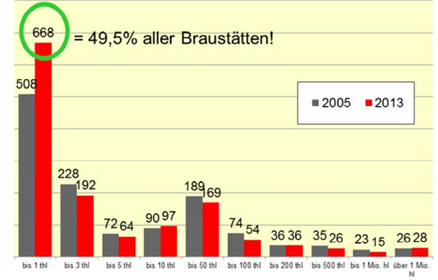When did craft beer hit Germany? 500 years ago!
Bavarian brewers and how they like to see the world. When asked when craft beer hit Germany, officials of the Bavarian Brewers Association like to respond: 500 years ago. That’s when the Bavarian Purity Law for beer was implemented (1516).
Next year’s big anniversary is already making itself felt. All efforts are taken to silence debate about the usefulness of the Purity Law for today’s brewers and subdue objections that it stands in the way of innovation.
No wonder, the Bavarian Brewers Association’s officials don’t like any comparison between Germany and the U.S. craft beer industry. Drawing on statistics they like to point out that there have always been small brewers in Germany. Small brewers never went away like in the U.S. thirty years ago when only a few major brewers ran the show.
Data prove that since 1993 the number of breweries with an output under 5,000 hl beer has risen 50 percent to 924 in 2013. There were a total of 1,347 breweries operating in Germany in 2013.
Digging deeper into data, it can be shown that 668 (or 49.5 percent) of all German breweries produce less than 1,000 hl beer annually, or 0.22 percent of total beer volumes in Germany.
Taken together, those brewing under 5,000 hl per year represent less than 1 percent of total beer. Still, when compared to the U.S., where there is about one brewery per 100,000 inhabitants, Bavaria alone has one brewery per 20,000 people.
Applying the U.S. definition of a craft brewer to Germany, the Bavarian Brewers Association likes to stress that by this definition all but a handful of German brewers are craft brewers, especially in terms of ownership (privately owned), size (under 6 million barrels) and beer styles (traditional).
As to beer styles, the Bavarian Brewers Association categorically refutes all criticism that German beer is boring, dominated by Helles, Weizen and Pils. In fact, Bavaria’s brewers produce over 40 beer styles. Should nevertheless Helles, Weizen and Pils lead in sales – that’s because of consumer demand.
Luckily, things are changing. Bavarian brewers are increasingly pushing their other beer styles while engaging in new styles, such as IPA, Stout and Porter. This is welcomed by the Bavarian Brewers Association as these novel styles help raise the profile of beer as such. But on one proviso: all these innovations are to fall within the limits set by the Purity Law.
Market observers say that for the time being – or until next year’s anniversary celebrations are over – there will not be any revolution brewing in the German beer market and the Purity Law will stand uncontested.
Whether the German Purity Law is really the big asset Germany’s brewers should exploit in the years to come remains to be seen. If you talk to German consumers of craft beer in Berlin, who have been to Italy, Belgium or the U.S., they invariably say they could not care less. All they want are interesting beers.


